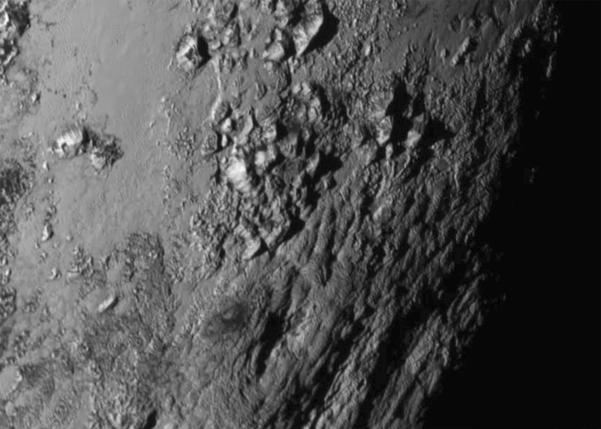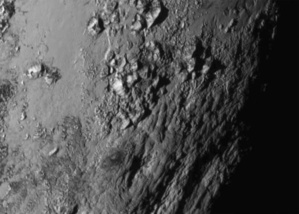N.A.S.A – 16 July 2015 – Reuters reports about the first sensational features of Pluto revealed by its recent close-ups. It has been the first time that the scientists took a close look at the tiny plante of our solar system, situated farthest from the heart-star of the solar system. These close-ups show a rising area, which are none other than rising mountain ranges on the icy planet’s surface.
The news reports that the mountains too are “made of ice”. Moreover, they are a “young” range of mountains which has surprisingly “crater-free surface”. The scientists of N.A.S.A involved in the “New Horizons mission” broke the said news on Wednesday. N.A.S.A has received the first ever image reporting of N.A.S.A which was sent by the “piano-sized spacecraft” across solar system. The said craft would be spending the next nine and half years surveying Pluto’s surface area of “7,800 miles”.
The New Horizon, spacecraft is wading its way through space, further into “the Kuiper Belt”, which refers to “a region of the solar system beyond Neptune”. Talking about the ‘topography’ of the area, the news informs that it said be holding “some 4.6 billion years” old “remnants” of the solar system formation, whereby the region is studded with innumerable tiny icy and rocky objects. It is a stony world at that end of the solar system wherein multiple “Pluto-like” objects float in the space.
Scientists are still to find out the mechanism whereby these big mountains were formed on Pluto, the “tallest of which” is almost equivalent to the height of the Rockies Mountains of Canada, whereby it juts out “11,000 feet” or “3,350 meters) into the Pluto’s sky. There has been another puzzling question before the scientists as to:
The news reports that the mountains too are “made of ice”. Moreover, they are a “young” range of mountains which has surprisingly “crater-free surface”. The scientists of N.A.S.A involved in the “New Horizons mission” broke the said news on Wednesday. N.A.S.A has received the first ever image reporting of N.A.S.A which was sent by the “piano-sized spacecraft” across solar system. The said craft would be spending the next nine and half years surveying Pluto’s surface area of “7,800 miles”.
The New Horizon, spacecraft is wading its way through space, further into “the Kuiper Belt”, which refers to “a region of the solar system beyond Neptune”. Talking about the ‘topography’ of the area, the news informs that it said be holding “some 4.6 billion years” old “remnants” of the solar system formation, whereby the region is studded with innumerable tiny icy and rocky objects. It is a stony world at that end of the solar system wherein multiple “Pluto-like” objects float in the space.
Scientists are still to find out the mechanism whereby these big mountains were formed on Pluto, the “tallest of which” is almost equivalent to the height of the Rockies Mountains of Canada, whereby it juts out “11,000 feet” or “3,350 meters) into the Pluto’s sky. There has been another puzzling question before the scientists as to:
“...why Pluto has such a young face”?
Pluto is a small “icy body” in nature, whose dimensions are even “smaller than Earth’s moon”. In fact, the scientists believed that it surface area of Pluto should have been “pocked with impact craters” as a result of “rocks and boulders” rain that take place in the “Kuiper Belt” region for “over eons”. Contrarily, the findings of New Horizon shocked the team members as it revealed that:
“...the surface of Pluto has somehow been refreshed”.
Scientists term the reason behind such activity to be “tied” with the presence of “underground ocean” along with other geological phenomenon, like “ice volcanoes” responsible for giving out “heat”. According to them, the mountain range of Pluto is not older than a “100 million years”, in Reuters’ language:
“...a relative blink compared to the age of the solar system.”
The first survey image-report of new Horizon covered an area of “150 miles” of Pluto’s surface which is situated near the “rugged equatorial region” of the planet. In fact, these close-ups have led the scientists to wonder about the possibility of an on-going geological activities in the apparently still “icy world”. Cathy Olkin, a team member of the New Horizon members told the media that:
"Pluto has so much diversity. We're seeing so many different features ... there’s nothing like it".
Furthermore, the primary moon of Pluto, namely Charon, took the entire team of scientists by surprise. They had thought that Charon was “geologically dead” for a long time. However, New Horizon revealed that the celestial body contains “troughs, cliffs and giant canyons”, all of which point finger towards a possible on-going “internal processes”, to which Olkin remarks:
"Charon just blew our socks off".
Moreover, the data received from the spacecraft monitoring the region of Kuiper Belt has been a tiny portion of the entire “pictures and science measurements” that were gathered by it on its way to the system of Pluto. The remaining contents of the treasure-trove to be “transmitted” back to the Earth over a period of “next 16 months”. In the lead scientists of the New Horizon team, Alan Stern’s words:
"I don't think any one of us could have imagined that it was this good of a toy store".






